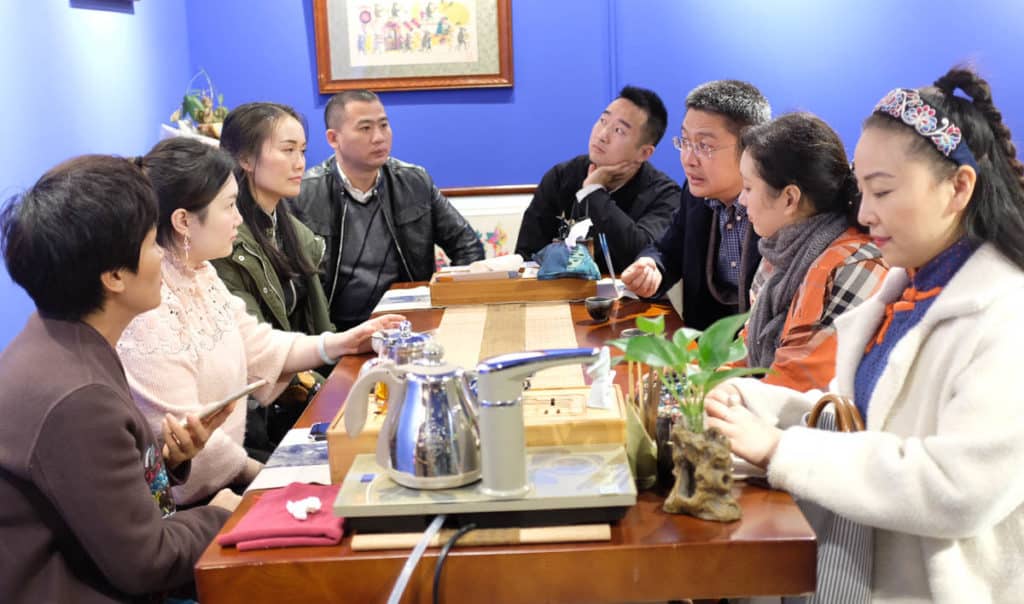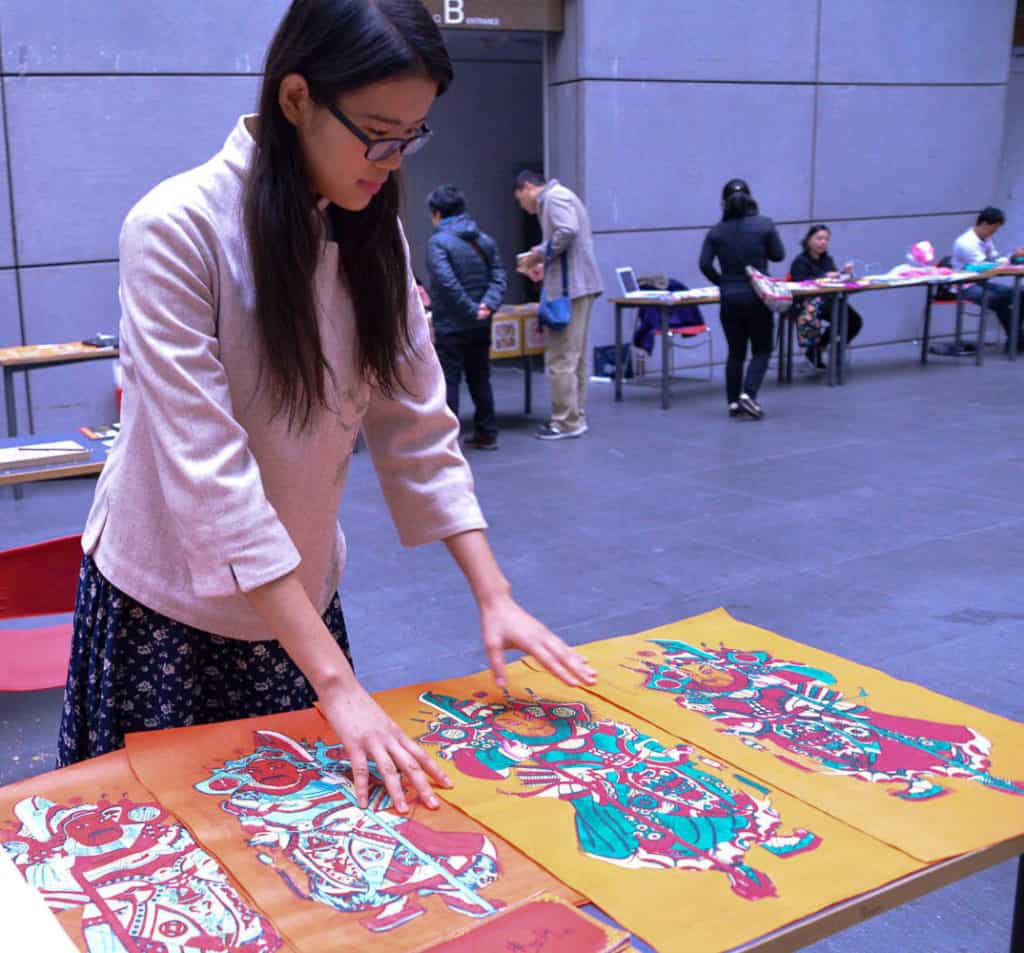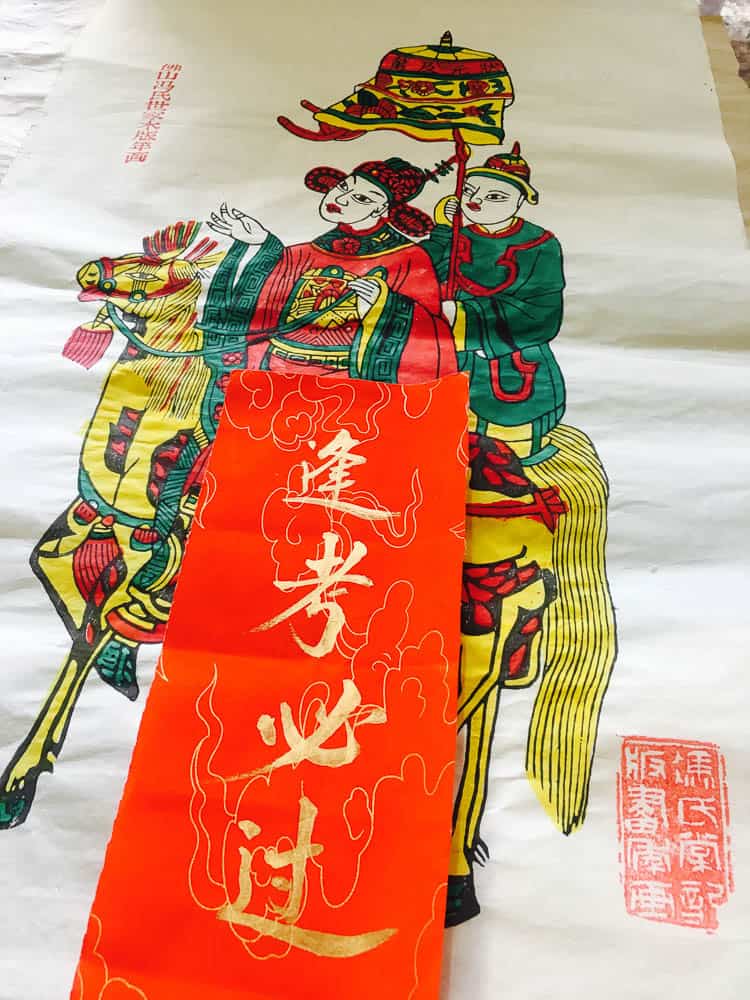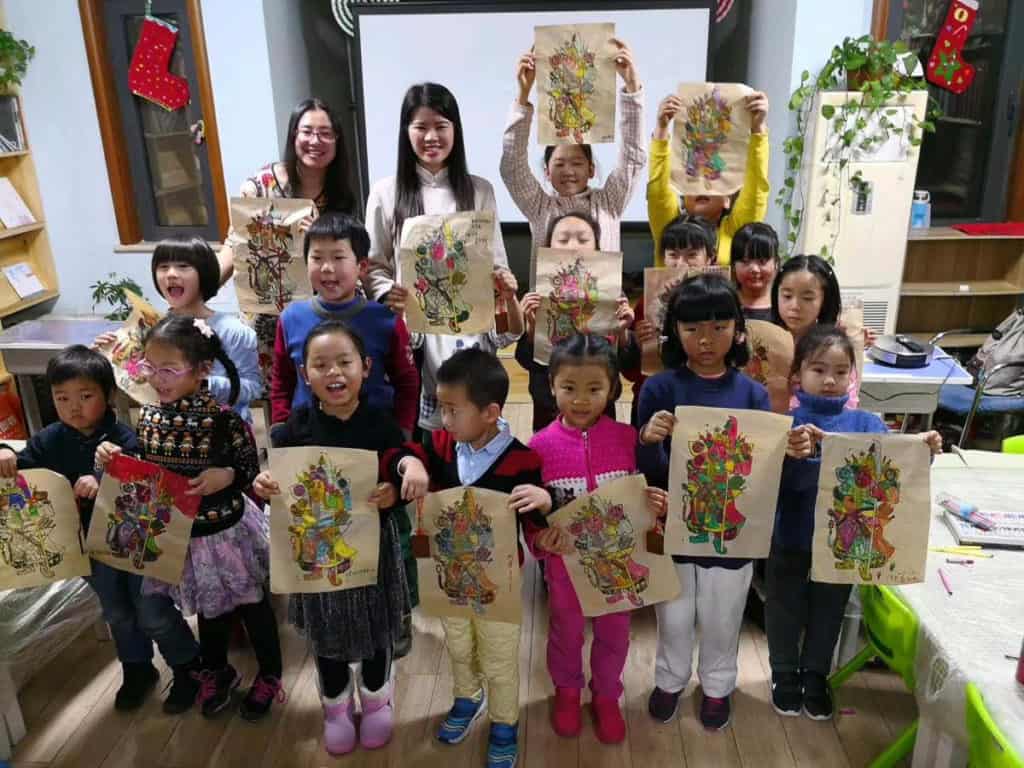- 7.“New Year Pictures Match-making Day”curated by LIU Zhongping,bring you a second child
- 5. “New Year Pictures Match-making Day”curated by LIU Zhongping,pass any examination
- 6.“New Year Pictures Match-making Day”curated by LIU Zhongping,farewell single
There has been much important research on the history of Chinese New Year pictures, but there are still different opinions on how to rescue New Year pictures from the brink of disappearance and how to fit them into the modern life. As far as I can see, the revival of New Year pictures is not something that can be achieved by making one or two field visits and publishing one or two articles, but something that needs to be actively engaged in oneself. That is to say, it is necessary to carry out social practice that help to activate traditional culture with a focus on inheritors rather than researchers.
In this regard, from the “Intangible Cultural Heritage Inheritors’ Training Program” to the “Revitalization Program of Chinese Traditional Crafts” to the recent “New Year Pictures Back to Spring Festival”, some explorations and attempts have been made around the inheritance and innovation of New Year pictures. New Year pictures practitioners, local people and all stakeholders have gradually regained confidence in the revival of New Year pictures. This has been achieved through activities ranging from inheritor’s study and training to holding exhibitions and cross-disciplinary dialogues, from developing experience-oriented craft courses to developing new products and expanding sales channels, under the guidance of the intangible heritage protection concepts of “Seeing People, Seeing Things, Seeing Life” and “Leading by Usage” in the new era,
The first step is always the hardest. On top of a good start, further progress is needed. It’s imperative to know the sticky issues and difficulties and come up with targeted, creative and feasible solutions. As a practitioner, I take the liberty of thinking about several key points in practice, offering advice and suggestions to practitioners and decision-makers, and hoping to contribute to the revival of New Year pictures. China has entered the twenty-first century. The social scenes that endow New Year pictures with meaning year after year have vanished. It is very difficult for us to ask people to change their house gates back to the old-fashioned style, and it is also very difficult for young people to observe the traditional festival customs. However, what we can do is not only to enshrine New Year pictures in museums, but also to keep pace with the times and find a place for New Year pictures in modern life.
1. To revive New Year pictures, a new generation of inheritors must be cultivated

1.Reunion with young generation of Hunan ICH inheritors at ZHONG Xinglin’s Woodprint Workshop,Changsha,2018
During the transition from planned to a market economy, the whole Chinese traditional craft industry is facing the challenge of training new inheritors, and New Year pictures are no exception. At the end of 2018, Mr PANG Dazhi, the national representative inheritor of Taohuawu woodprint New Year pictures, passed away in Suzhou, and Ms YE Baofen, 75-year-old, was hospitalized due to illness. But the woodprint creation was not interrupted. Taohuawu New Year Pictures Group was incorporated into Suzhou Arts and Crafts Technology College in 2001 and remained a collective-owned enterprise. Every year, the college sends students to study in the Taohuawu New Year Pictures Group. Up to now, 21 students have mastered the craftsmanship, and six of them have chosen to stay in the group and become its backbone. The other students either chose to work at the Taohuawu Woodprint New Year Picture Museum or set up their own studios. This is a successful case of the integration of modern vocational education and intangible cultural heritage transmitting, which can serve as an example for other New Year pictures production areas.
In addition to the vocational education system, the younger generation who inherit New Year pictures, such as LI Li of Kaifeng Woodprint New Year pictures in Henan province, LIU Zhongping of Foshan Woodprint New Year pictures in Guangdong province, ZHONG Xinglin of Tantou Woodprint New Year pictures in Hunan province, etc., have also stood out in the process of participating in the “Intangible Cultural Heritage Inheritors’ Training Program”, in Tsinghua and in other universities, and become the models of the “second generation of inheritors”. They are all college graduates and millennials. Apart from promoting New Year pictures in innovative ways, they have mastered the essential skills in the process of learning and have the ability to design new patterns. In light of this fact, it is necessary for the relevant government agencies to help the young generation of inheritors go out for exchange. In this regard, several examples can be learnt from the experiences of Foshan, Guangzhou of Guangdong Province and Yushu of Qinghai Province, where young craftsmen in the same area were selected and sent out for training in groups. After they finished their study and came back, they got to know each other and could help each other.
2. To revive New Year pictures, the technical competitiveness must be strengthened
People are accustomed to calling traditional woodprints used in folk-custom activities, “New Year pictures”. However, it is not an accurate term in a strict sense. Actually, the “New Year pictures” posted during the Spring Festival are only one usage of traditional woodprints. The same technique can also be applied to print images and signs of gods, drama stories or commercial posters, which do not necessarily connect to Spring Festival or any festival. For instance, in Dali of Yunnan Province and other regions, there are still “Jiama” (another name for traditional woodprints) that can be pasted and burned in all kinds of situations in daily life. From a broader perspective, “New Year pictures” or “Jiama” are only one among many applications of traditional woodprint techniques. The same technique can also be used to print scriptures for temples, books and illustrations for educated class. The appellation of “New Year pictures” is derived from its function, but the same technique can be used for various purposes and the same woodprint workshop can produce products with different functions. From a technical point of view, at the heart of New Year pictures is woodcutting and printing (sometimes half printing and half painting), which can be classified as “print” in a broad sense.
With the emergence of modern print technology, traditional print has become a so-called low technology. The modern print has greatly impacted the traditional manual engraving and printing, but does this mean that “high-tech” will take the place of “low-tech” all at once? Think about the ceramic and textile industries. Although both industries have already entered the age of mass production, K’o-ssu (silk tapestry), brocade, handmade ceramics and wood-fired ceramics have not disappeared. Rather, they are increasingly needed for high-quality lifestyle. If we look at the traditional printing industry, manual printing has not been completely replaced by machines in western countries but has been transformed into a more artistic and personalized form of creation. It can be seen that traditional craftsmanship is not necessarily replaced by modern technology.
Handmade prints originating from Europe have become a large art category and a university discipline in China, from engraving, etching, woodcut and lithography to silkscreen. By contrast, the Chinese traditional prints are on the verge of disappearance. This is certainly related to the external social change, but it also has something to do with the practitioners themselves. In the domestic handmade prints industry, it is common to find people who can only print but don’t know how to cut, or who can only engrave the old patterns but not the new ones. The whole industry needs to think over on it. The revival of New Year pictures should be more than just a good wish. It hinges on core competitiveness in craftsmanship. At least the techniques of the traditional woodprint workshops should be developed to a level which can be compared with print studios at colleges and universities. They may have different points, but the whole level of them should be comparable.
3. To revive New Year pictures, attention must be paid to the quality of materials and products

3. LIU Zhongping,the only apprentice of Master Feng,attended the“Intangible Cultural Heritage Inheritors’ Training Program”at Tsinghua University,Beijing,2016.JPG
With the upgrade of consumption in China, people are paying more and more attention to the quality of life. Compared with artificial materials, natural raw materials used in traditional crafts are not only scarce, but also contain the original connection between human and nature, and are increasingly favoured by consumers today. In ancient times, New Year pictures were fast consumables with low prices, but even for such a thin piece of paper, the materials are very sophisticated. The pigments used in New Year pictures have been impacted by western chemical pigments since modern times. Now that people are pursuing a more exquisite lifestyle, can we return to the use of mineral and plant pigments? Can the woodblocks used for cutting be subject to more careful selection, and can the New Year picture industry have more interactions with the woodcarving industry? Ancient block carving illustrations are often based on literati painting and calligraphy. Can today’s woodblock printing community re-establish contact with the painting and calligraphy community? Especially for the paper used for printing New Year pictures or illustrations, can it be made by hand, which combines the techniques of two or more forms of intangible cultural heritage?
In ancient times, New Year or worship prints were often sold by paper shops. Can the relationship between the two be reconstructed today? Professor YUAN Bo of the Academy of Arts & Design, Tsinghua University, has paid close attention to handmade paper and traditional prints in recent years. Recently, YUAN and I participated in the activities of Foshan Woodprint New Year Pictures Returning to the Spring Festival. In the near future, both of us hope that the inheritors of this technique can have more contact with the inheritors of handmade paper craftsmanship. Foshan woodprints were flourishing at the same time as the paper and pigment industries. There were more than a dozen trades related to the New Year pictures business, including binding, lantern, book and stationery. The essence of culture lies in connections between people and people, people and products. The subtlest cultural connection is embodied not only in language and writing, but also in the merger of skills and the synthesis of materials, thus creating a world with rich implications. In essence, the world of New Year pictures was such a world with rich implications.
The historical implications of New Year pictures are rich, so the innovation in the making of New Year pictures cannot be linear or one-dimensional. In the past, most creative development of New Year pictures only focused on patterns which were printed on mugs or T-shirts. People believed that this was innovation. However, the vehicle carrying these “creative ideas” are actually fast and mass-made jokes, which does not enhance but degrade the cultural value of New Year pictures.
Arnold Hauser retold a story in his book The Social History of Art. During the Renaissance, someone handed a crucifix to a dying believer, but the believer thought the crucifix was too ugly. He refused to kiss the statue and asked for another one. Hauser commented that we cannot imagine such a thing happening in an era before the Renaissance. China, which has said goodbye to the stage of struggling for food and clothing and entered a new era, is having great cultural prosperity and development. Therefore, whether it is the creation of New Year pictures or its derivatives, we need to look at the details of materials, techniques and so on in order to better meet people’s expectations for a better life.
4. To revive New Year pictures, the works must appeal to emotion and meet the needs in life
The traditional printing technique is used to print books and classical texts which help to pass down the fame of literati or religious culture. When used in folk festivals and customs, it carries folk cultures and beliefs. Folk beliefs are very important to traditional New Year pictures. The gods printed on paper are their embodiment. The auspicious patterns printed on paper will bring good luck to people. The patterns in New Year pictures are visual representations of folk beliefs and values. Needless to say, there will inevitably be elements unacceptable to modern people, such as affirmation of feudal ruling and the craving for promotion and wealth. In a hierarchical society where the ideology of the ruling class takes a dominant position, it is inevitable for ordinary people to develop such ideas. However, the patterns such as “wish kids a promising future” and “soon awarded as a noble” not only reflect the social hierarchy at that time, but also point to the simple hankering of the people for a better life. So it cannot be denied as valueless with a broad brush.
In terms of the pursuit for a better life, it’s basically the same in ancient and modern times. The good things in life our ancestors pursued, such as enjoying a romantic wedding night, winning an exam for selection and encountering an old friend in a trip, are also our dreams. Although the scenes and characters are different, the feelings are similar. LIU Zhongping, the inheritor of Foshan woodprint, has made many useful attempts in this regard. The “New Year Pictures Match-making Day” curated by her in a time-honoured New Year pictures store has attracted many single people and achieved remarkable results. It is not surprising to see that some participants find their partners given that so many single men and women gathered there. Her New Year Picture experience event themed with “Champion of Imperial Examination” has offered blisses to many people who sat all kinds of exams (including driving license examination). Here, the ancient New Year pictures have become the witness and blessing of a better life.
Even if we succeed in reviving the New Year pictures, proper pasting is needed to make them look lively. In the past, people used starch paste, but now people use industrial glue which has a bad smell. In a modern living environment, it’s not easy to keep them flat when pasting New Year pictures on steel-plate doors, while indoor walls are not suitable for direct pasting. I once suggested LIU Zhongping that he consider this option: is it possible to make paste herself and send it to the buyer in a small bottle? This not only provides convenience for users, but also enhances the sense of ceremony, and can also awaken childhood memories.
In addition, should we study the mounting and placement of New Year pictures to make it easier for them to fit into modern homes? At present, the common practice is to frame the pictures and hang them on the wall, but the problem is that the walls in the home are limited. In addition, frames on the market are often not exquisitely made and difficult to match with New Year pictures in style. Although these problems seem trivial, they are also something that practitioners of New Year pictures have to consider. New Year pictures shops used to serve thousands of families, so today they should also have a good sense of service.
Note: A reduced version of this article has been published in the 13th edition of Guangming Daily on January 30, 2019, under the title of “How New Year Pictures Fit into the Modern Scenes of New Year Festival”.
Author
 Anying CHEN is the chair of the Art History Department, Academy of Arts & Design, Tsinghua University, associate professor and PhD supervisor for art theories, aesthetics, intangible cultural heritage and traditional crafts, modern and contemporary art. He is also the deputy director of the Key Laboratory of Traditional Craft Techniques and Materials Research, Ministry of Culture and Travel. He took charge of several research projects such as Contemporary Developing of Chinese Traditional Crafts, Traditional Crafts and Internet Promotion and so on. He co-curated many events such as the 1st Beijing International Design Triennial (2011), Reproduction: Chinese Contemporary Arts and Crafts Seminar (2014), Youth Forum of Traditional Crafts (2016- ), and a series of exhibitions and forums on traditional crafts and intangible cultural heritage since 2015. He won the second prize of Education Ministry’s Sixth Outstanding Scientific Research Achievement Award and “National Excellent Individual for Intangible Culture Heritage Safeguarding” awarded by Ministry of Culture and Travel, China.
Anying CHEN is the chair of the Art History Department, Academy of Arts & Design, Tsinghua University, associate professor and PhD supervisor for art theories, aesthetics, intangible cultural heritage and traditional crafts, modern and contemporary art. He is also the deputy director of the Key Laboratory of Traditional Craft Techniques and Materials Research, Ministry of Culture and Travel. He took charge of several research projects such as Contemporary Developing of Chinese Traditional Crafts, Traditional Crafts and Internet Promotion and so on. He co-curated many events such as the 1st Beijing International Design Triennial (2011), Reproduction: Chinese Contemporary Arts and Crafts Seminar (2014), Youth Forum of Traditional Crafts (2016- ), and a series of exhibitions and forums on traditional crafts and intangible cultural heritage since 2015. He won the second prize of Education Ministry’s Sixth Outstanding Scientific Research Achievement Award and “National Excellent Individual for Intangible Culture Heritage Safeguarding” awarded by Ministry of Culture and Travel, China.






